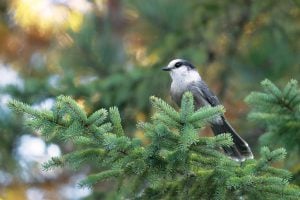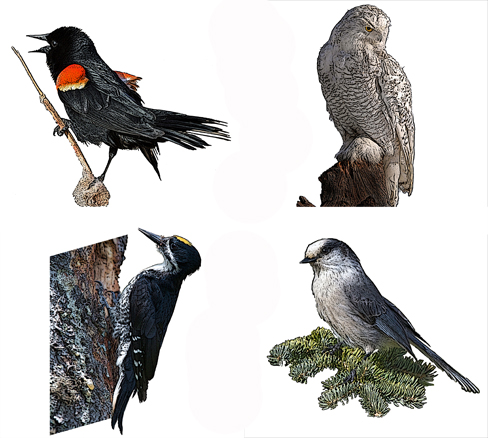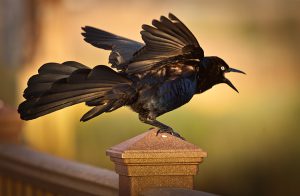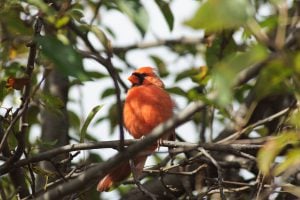
Wildlife
Excerpt from The Canada Jay as the National Bird of Canada
Editor-in-chief and associate publisher Aaron Kylie contributed this chapter to a compilation book about the Canada Jay
- 1532 words
- 7 minutes
This article is over 5 years old and may contain outdated information.
Wildlife

Canada is home to more than 450 bird species, yet somehow Canada is still one of the few nations that does not recognize a national bird. Canadian Geographic, with the help of Bird Studies Canada and other bird conservation organizations, is hoping to change that with the National Bird Project. Vote for your favourite species and contribute your own short essay today at The National Bird Project.
The essays collected below are Canadian Geographic‘s editors’ picks for the best recent reader submissions to the National Bird Project website. We will continue to feature our favourite new pieces on the CG Compass blog. Join the discussion on Twitter using #CanadaBird!
RED-WINGED BLACK BIRD
By: Danika Didur-Tate, Olympia, Wash.
I am a Canadian citizen and Environmental Educator. I spend my days with visiting school groups at the Wildlife Refuge where I work, and have learned the wonder and importance of accessible birds. I am fascinated and astounded by snowy owls as much as the next person, but most people will go their lives without ever seeing one. On the other hand, a good majority of people have seen crows, pigeons, Canada geese, etc. Those are the birds that the average person interacts with. Wildlife lives with us in our cities and towns, in our parking lots and on our roofs. We sometimes mistakenly equate rare with wild. This is a dangerous confusion, for we then ignore the life that is with us every day, and we can forget to learn from and enjoy the species that make their homes a little closer to ours.
It is for this reason that I chose a common bird. As a national symbol, the red-winged blackbird is visually striking, but it also gives people the opportunity to have experiences with them. Real-world interactions are those that really capture our hearts and our imaginations. I would rather have a common bird in front of me than a striking and rare bird in a photograph. And I know at least 3,000 students and adults who would agree with me.
SNOWY OWL
By: Tim Hildebrand, Saskatoon, Sask.
The snowy owl carries a connotation of northern wisdom. In a world clouded by friction, greed and regional hostilities, I think a global level head is more relevant than ever. Canada’s international discretion transcends parties and governments, and remains consistent from administration to administration because it’s a reflection of a highly-educated people, toughened by elements and hard episodes of war, blessed by well-stewarded natural resources and friendly borders and committed to care for the weak, the poor and the suffering.
In case people confuse the wise and watchful character of the snowy owl for weakness, it’s good to remember that it is also a powerful and deadly hunter with few natural enemies, and no enemies whatsoever that it fears attacking when it’s defence is tested. The snowy owl is considered an exceptionally patient hunter, and maybe it’s this above all that demonstrates its Canadian-ness. The United States guaranteed its freedom from British rule with the loss of 50,000 dead and wounded. Canada waited, carefully calculating and negotiating step-by-step, for 200 years, to achieve the same end in 1980 without a single loss of life. Wisdom indeed.
BLACK-BACKED WOODPECKER
By: Tracy Allard, Whitehorse, Yukon
First let us eliminate the birds which are already official provincial birds in Canada: great horned owl (Alta.), steller’s jay (B.C.), great grey owl (Man.), black-capped chickadee (N.B.), Atlantic puffin (N.L.), osprey (N.S.), common loon (Ont.), blue jay (P.E.I.), snowy owl (Que.), sharp-tailed grouse (Sask.), gyrfalcon (N.W.T.), rock ptarmigan (Nunavut), common raven (Yukon).
And some of those from northern U.S. states: willow ptarmigan (Alaska), black-capped chickadee (Maine), American robin (Michigan).
Birds are of such value and their numbers are in so many cases dwindling, that for different places to use the same official bird is a disservice to all the other birds who need our attention.
The black-backed woodpecker is one of the truly distinctive Canadian birds. It has a very distinctive call and resides in Canada all year long. Though a rare occurrence in Nunavut, the territory is at the very edge of the bird’s regular range, and will be seen there more frequently as global warming occurs and forested ranges shift. So Nunavut would be at the forefront of the northern advance of this beautiful woodpecker.
This bird thrives on dead trees, whether from insect kills or fires, and as global warming contributes to the burning of more of our forests, it is quite possible we’ll be seeing more of these black-backed woodpeckers. It will also be important for us to manage these dead forests properly, so as to not completely eliminate the bird’s habitat.
The black-backed woodpecker is a bird of great interest; it merits more study and truly deserves our protection and caring.
GRAY JAY
By: Dar Cullihall, Rocky Harbour, N.L.
The gray jay, sometimes called the whiskey jack, was often referred to as the “moose bird” by my late father and others. It’s not difficult to speculate how this bird became the moose bird to many Newfoundlanders and Labradorians, because it seems to have that uncanny way of appearing in a nearby treetop or hopping confidently from tree stump to tree stump whenever hunters, woodcutters or hikers ventured into the wilderness and paused for a snack. If a fire was lit to boil kettles or warm food, the smoke attracted this bird almost immediately. Where they would come from, almost appearing from nowhere, was always a slight mystery to us all.
In addition to this, many travellers carried with them a belief (call it a superstitious belief) that, somehow, to view this bird along the trail or to have it enter the campsite in search of handouts brought good luck to everyone in the party. I was taught that under no circumstances should this bird be harmed in any way, and that always, always, a part of one’s snack had to be shared with them. They hopped around with such confidence that they seemed to know that no harm would come to them. Many personal pictures are available of those birds feeding from one’s hand, perched on one’s knee, and even eating a piece of bread while perched comfortably on one’s bald head. Usually, wild birds are easily spooked, but for some reason this bird carries with it a certain degree of confidence, perhaps knowing it is protected by legend.
I remember some years ago when a younger man, travelling in the company of a snowmobile party (and obviously unaware of the near deity placed on moose birds), hurled a piece of orange peel at one, striking it in the wind and causing the bird to flutter, awkwardly, before recovering in a nearby treetop. One of the older gentlemen in the group was quick to rise and in an irritated voice reminded the young man that harming this bird in any way was taboo. Taken aback, the young man sheepishly apologized and remained silent for some time. The older man said, “You know, my son, before you get home from this venture, you or someone in this group will have some sort of problem. Something will go wrong and it’s all because of what you did to that little bird!” As the story is told, it was later in the evening, as the group was returning home, that the drive track on the young man’s snowmobile came apart and left him stranded deep in the wilderness. Thankfully, his friends invited him to ride double, and all arrived home safely.
There are many more stories told of this wonderful bird, cementing the belief that it is, indeed, protected by higher forces and that it is on this Earth to offer hope and protection to all who travel into the deepest forests. I have never ventured into the deep forests without seeing one, and I can’t help but smile when I do, because I feel that it is following me to offer its comfort.
That is why I nominate the ‘moose bird’ as Canada’s national bird. Thank you so much for allowing me to share in the competition and share my story.
Are you passionate about Canadian geography?
You can support Canadian Geographic in 3 ways:

Wildlife
Editor-in-chief and associate publisher Aaron Kylie contributed this chapter to a compilation book about the Canada Jay

Travel
Spread your wings with birdwatching’s elite guard in south Texas

Wildlife
Canada is home to more than 450 bird species, yet somehow Canada is still one of the few nations that does not recognize a national bird. Canadian Geographic, with the help…

Wildlife
You’ll be amazed at the feathered friends you can attract to your yard by following these simple tips